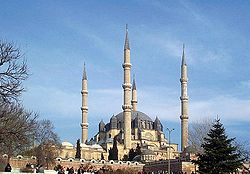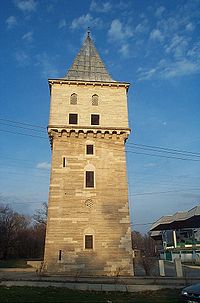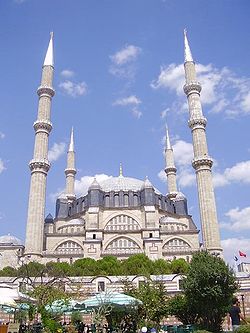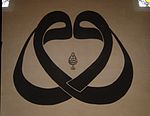- Edirne
-
"Adrianopolis" redirects here. For other uses, see Adrianopolis (disambiguation)."Adrianople" redirects here. For the Battle of Adrianople, see Battle of Adrianople. For the Treaty of Adrianople, see Treaty of Adrianople.
Edirne — Town — Selimiye Mosque, built by Mimar Sinan in 1575. 
Justice TowerLocation of Edirne within Turkey. Coordinates: 41°40′N 26°34′E / 41.667°N 26.567°E Country  Turkey
TurkeyRegion Marmara Province Edirne Government - Mayor Hamdi Sedefçi (CHP) Population (2010) - Urban 138,793 Time zone EET (UTC+2) - Summer (DST) EEST (UTC+3) Licence plate 22 Edirne is a city in Eastern Thrace, the northwestern part of Turkey, close to the borders with Greece and Bulgaria. Edirne served as the capital city of the Ottoman Empire from 1365 to 1453, before Constantinople (Istanbul) became the empire's new capital. At present, Edirne is the capital of the Edirne Province in Turkish Thrace. The city's estimated population in 2010 was 138,793, up from 119,298 in 2000. It has consulates of Bulgaria, Germany (Honorary), Greece, Romania (Honorary) and Slovakia (Honorary). Its sister cities are Haskovo and Yambol in Bulgaria and Alexandroupolis in Greece. There is a Jewish community.[1]
Contents
Etymology
The city was founded as Hadrianopolis (Aδριανούπολις), named for the Roman Emperor Hadrian. This name is still used in the Modern Greek (Αδριανούπολη). The English name Adrianople, by which the city was known until the Turkish Postal Service Law of 1930, has fallen into disuse. Turkish Edirne, Bulgarian and Macedonian Одрин (Odrin, [’odrin]), and Serbian Једрене (Jedrene) are adapted forms of the name Hadrianopolis. (see also its other names)
History
The area around Edirne has been the site of no fewer than 16 major battles or sieges, from the days of the ancient Greeks. Military historian John Keegan identifies it as "the most contested spot on the globe" and attributes this to its geographical location.
According to Greek mythology, Orestes, son of king Agamemnon, built this city as Orestias, at the confluence of the Tonsus (Toundja) and the Ardiscus (Arda) with the Hebrus (Maritza). The city was (re)founded eponymously by the Roman Emperor Hadrian on the site of a previous Thracian settlement known as Uskadama, Uskudama or Uskodama or Uscudama . It was the capital of the Bessi.[2] Hadrian developed it, adorned it with monuments, changed its name to Hadrianopolis, and made it the capital of the Roman province of Haemimont, or Thrace. Licinius was defeated there by Constantine I in 323, and Valens was killed by the Goths in 378 during the Battle of Adrianople (378). In 813 the city was seized by Khan Krum of Bulgaria who moved its inhabitants to the Bulgarian lands towards the north of the Danube.
During the existence of the Latin Empire of Constantinople, the Crusaders were decisively defeated by the Bulgarian Emperor Kaloyan in the battle of Adrianople (1205). Later Theodore Komnenos, Despot of Epirus, took possession of it in 1227, and three years later was defeated at Klokotnitsa by Asen, Emperor of the Bulgarians.
Following its capture by the Ottoman Sultan Murad I in 1365, Edirne served as the capital city of the Ottoman Empire from 1365 to 1453; until the Ottoman conquest of Constantinople (Istanbul) which became the empire's new capital.
Under Ottoman rule Adrianople was the principal city of a vilayet (province) of the same name, both of which were later renamed as Edirne. Sultan Mehmed II, the conqueror of Constantinople, was born in Adrianople. It was here that he fell under the influence of some Hurufis known as Certain accursed ones of no significance, who were burnt as heretics by Mahmut Paşa.[3]
Sultan Mehmed IV left the palace in Constantinople and died in Edirne in 1693.
Bahá'u'lláh, the founder of the Bahá'í Faith, lived in Edirne from 1863 to 1868. He was exiled there by the Ottoman Empire before being banished further to the Ottoman penal colony in Akka. He referred to Edirne in his writings as the "Land of Mystery".[4]
Edirne was a sanjak centre during the Ottoman period and was bound to, successively, the Rumeli Eyalet and Silistre Eyalet before becoming a province centre at the beginning of the 19th century. Edirne Province comprised the sanjaks of Edirne, Tekfurdağı, Gelibolu, Filibe and İslimye before 1878.
 Trakya University in Edirne
Trakya University in Edirne
The subdivisions of the Edirne Province before 1878 were:[5]
- Sanjak of Edirne: Kazas of Edirne, Dimetoka, Kırkkilise, Maa Çimren Cisr-i Mustafa Paşa, Cisr-i Ergene, Babay-ı Atik, Beykar Hisar, Maa Hatunili-Kızılağaç, Havsa, Ferecik.
- Sanjak of İslimye: Kazas of İslimye, Ahyolu, Misivri, Burgaz, Aydos, Karinabad, Yanbolu and Zağra-i Cedit.
- Sanjak of Gelibolu: Kazas of Gelibolu, Gümülcine, Şarköy, Enez, Evreşe and Keşan. Gümülcine was a kaza of the Filibe sanjak at the beginning of the 19th century.
- Sanjak of Filibe: Kazas of Filibe, Pazarcık, Zagra-i Atik, Hasköy, Kazanlı, Çırpan, Ahiçelebi, Sultanyeri.
- Sanjak of Tekfurdağı: Kazas of Tekfurdağı, Vize, Çorlu, Lüleburgaz, Malkara, Midye, Hayrabolu.
The subdivisions of the Edirne Province between 1878-1912 were:[6]
- Sanjak of Edirne: Kazas of Edirne, Havsa, Dimetoka, Mustafapaşa, Ortaköy, Cisr-i Ergene and Kırcaali.
- Sanjak of Kırkkilise: Kazas of Kırkkilise, Ahtabolu, Vize, Midye, Lüleburgaz, Babaeski and Tırnovacık.
- Sanjak of Gelibolu: Kazas of Gelibolu, Eceovası (its center was Maydos and renamed as Eceabat in 1923), Mürefte, Şarköy and Keşan.
Edirne was briefly occupied by imperial Russian troops in 1829, during the Greek War of Independence; and in 1878, during the Russo-Turkish War of 1877-1878. The city suffered greatly in 1905 from a conflagration. In 1905 it had about 80,000 inhabitants, of whom 30,000 were Muslims (Turks and some Albanians, Roma and Circassians); 22,000 Greeks; 10,000 Bulgarians; 4,000 Armenians; 12,000 Jews; and 2,000 more citizens of non-classifiable ethnic/religious backgrounds. Edirne was a vital fortress defending Ottoman Constantinople and Eastern Thrace during the Balkan Wars of 1912-13. It was briefly occupied by the Bulgarians in 1913, following the Battle of Odrin; and by the Greeks between the Treaty of Sèvres in 1920 and the end of the Turkish War of Independence in 1922.
According to the 2007 census, Edirne Province had a population of 382,222 inhabitants. The city is a thriving center of commerce for woven textiles, silks, carpets and agricultural products.
Ecclesiastical history
Adrianople was made the seat of a Greek metropolitan and of a Gregorian Armenian bishop, Adrianople is also the centre of a Bulgarian diocese, but not recognized and deprived of a bishop. The city also had some Protestants. The Latin Catholics, foreigners for the most part, and not numerous, were dependent of the vicariate-apostolic of Constantinople. At Adrianople itself were the parish of St. Anthony of Padua (Minors Conventual) and a school for girls conducted by the Sisters of Charity of Agram. In the suburb of Karaağaç were a church (Minor Conventuals), a school for boys (Assumptionists) and a school for girls (Oblates of the Assumption). Each of its mission stations, at Tekirdağ and Alexandroupoli, had a school (Minor Conventuals), and there was one at Gallipoli (the Assumptionists).
Around 1850, from the standpoint of the Oriental Catholics, Adrianople was the residence of a Bulgarian vicar-apostolic for the 4,600 Uniats of the Ottoman vilayet (province) of Thrace and after 1878 - of the principality of Bulgaria. They had 18 parishes or missions, 6 of which were in the principality, with 20 churches or chapels, 31 priests, of whom 6 were Assumptionists and 6 were Resurrectionists; 11 schools with 670 pupils. In Adrianople itself were only a very few United Bulgarians, with an Episcopal church of St. Elias, and the churches of St. Demetrius and Sts. Cyril and Methodius. The last is served by the Resurrectionists, who have also a college of 90 pupils. In the suburb of Karaağaç, the Assumptionists have a parish and a seminary with 50 pupils. Besides the Uniate Bulgarians, the above statistics included the Greek Catholic missions of Malgara (now Malkara) and Daoudili (now Davuteli village in Malkara), with 4 priests and 200 faithful, because from the civil point of view belonged to the Bulgarian Vicariate.
Later however, the Roman Catholic diocese was discontinued, and exists only in name as a titular metropolitan archbishopric, under the full name Hadrianopolis in Haemimonto to distinguish it from several other titular sees named Hadrianopolis.
Climate
Edirne has a humid subtropical climate (Köppen climate classification: Cfa). with long, hot summers and cold and occasionally snowy winters.
Climate data for Edirne Month Jan Feb Mar Apr May Jun Jul Aug Sep Oct Nov Dec Year Record high °C (°F) 20.5
(68.9)23.2
(73.8)28.0
(82.4)29.8
(85.6)35.3
(95.5)42.6
(108.7)44.1
(111.4)40.7
(105.3)37.8
(100.0)35.8
(96.4)28.0
(82.4)22.8
(73.0)44.1
(111.4)Average high °C (°F) 6.7
(44.1)9.2
(48.6)13.5
(56.3)19.2
(66.6)24.6
(76.3)29.3
(84.7)31.7
(89.1)31.6
(88.9)27.1
(80.8)20.5
(68.9)13.4
(56.1)8.0
(46.4)19.57
(67.22)Average low °C (°F) −0.6
(30.9)0.1
(32.2)2.9
(37.2)7.0
(44.6)11.4
(52.5)15.4
(59.7)17.3
(63.1)17.1
(62.8)13.3
(55.9)9.1
(48.4)4.7
(40.5)1.1
(34.0)8.23
(46.82)Record low °C (°F) −19
(−2.2)−19
(−2.2)−12
(10.4)−4.1
(24.6)0.7
(33.3)6.0
(42.8)9.3
(48.7)9.4
(48.9)4.2
(39.6)−3.7
(25.3)−6.6
(20.1)−13.4
(7.9)−19
(−2.2)Precipitation mm (inches) 54.3
(2.138)48.9
(1.925)50.2
(1.976)45.3
(1.783)54.9
(2.161)39.2
(1.543)34.2
(1.346)28.6
(1.126)38.1
(1.5)52.8
(2.079)72.1
(2.839)67.7
(2.665)586.3
(23.083)Avg. rainy days 11.5 8.1 9.3 10.3 10.0 8.0 5.5 4.8 4.9 7.1 10.4 12.9 102.8 Sunshine hours 93 112 155 210 248 300 341 310 240 155 90 62 2,316 Source: Devlet Meteoroloji İşleri Genel Müdürlüğü [7] Culture, sites and partnership with Europe
Situated near the Greek (7 km) and Bulgarian (20 km) borders, this city is famed for its many mosques, domes and minarets. Adrianople contains the ruins of the ancient palace of the Sultans and the Selimiye Mosque, one of the most important monuments in this ancient province; built in 1575 and designed by Turkey's greatest master architect, Mimar Sinan, it has the highest minarets in Turkey, at 70.9 meters and a cupola three or four feet higher than that of St. Sophia in Istanbul. Carrying the name of the then reigning the Ottoman Sultan Selim II, this mosque represents Turkish marble handicrafts and it is covered with valuable tiles and fine paintings.
Another notable building is the Trakya University's Bayezid II Külliye Health Museum, an important monument with its complex construction comprising many facilities used in those times.
Besides the mosques, there are different sites to be visited in Edirne, all reflecting its rich past. The most prominent place being the Edirne Palace, which was the "Palace of the Empire" built during the reign of Murad II. There are caravansaries, like the Rustem Pasha and Ekmekcioglu Ahmet Pasha caravansaries, which were designed to host travelers, in the 16th century.
Of Edirne's Christian heritage, there remain two Bulgarian Orthodox churches: Saint George (dating to 1880) and Saints Constantine and Helena (built in 1869). The Bulgarian churches were reconstructed in the 2000s with the cooperation of Turkey, using mostly Bulgarian state funds. They are both in a good condition today; Saint George also has a Bulgarian library and an ethnographic collection. The two Bulgarian churches are the only functioning Christian places of worship in the city today,[8][9] as none of the Greek churches are active or even preserved.[citation needed] Saraçhane Bridge is one of several old bridges.
A cultural partnership with Lörrach in Germany has been started in 2006. The goal is to exchange pupils and students to improve their cultural skills and understanding.
Festivals
Edirne is home to the traditional oil-wrestling tournement called Kırkpınar. Held every year in June, it is said to be the oldest active sport organization after the Olympic Games that were refounded only after centuries of inactivity.
Another international festival in Edirne is Kakava, a celebration of Romani people held on May 5 each year.
Economy
Edirne's economy largely depends on agriculture. 73% of the working population work in agriculture, fishing, forests, hunting. There are lots of things that are cultivated here. Its lowlands are productive. The field crop cultivation has developed so much here. Corn, sugarbeet and sunflower are the first. Melon, watermelon and viniculture are advanced. For the last decade, the agricultural products have doubled. Corn, rice, sunflower, sugarbeet, tomato, eggplant, melon, watermelon, grape are cultivated so much.
The through highway with an important role in global transport that connects Europe to Middle East and Anatolian to Istanbul passes through Edirne.
Also, the existence of many historical and natural touristic places and events lead the fact that tourism has become a leading component of the economic growth of the city in recent years.
Industry has also been developing. Especially industry based on agriculture (agro-industries) are important in the city economy.
Education
- Trakya University linked with Loerrach through the Erasmus programme of the EU
- Website Trakya University Edirne
- University of Cooperative Education Loerrach
High Schools
- Beykent Educational Institutions
- 80th Year of Republic Anatolian High School (80. Yıl Cumhuriyet Anadolu Lisesi in Turkish)
- Edirne High School (Anatolian High School) (Edirne Lisesi in Turkish)
- Edirne Yildirim Anatolian High School (Edirne Anadolu Lisesi - Yıldırım Anadolu Lisesi in Turkish)
- Edirne Anatolian Teacher Training High School (Edirne Anadolu Öğretmen Lisesi in Turkish)
- Edirne Suleyman Demirel Science & Maths High School (Edirne Fen Lisesi in Turkish)
- Edirne İlhami Ertem High School(Edirne İlhami Ertem Lİsesi in Turkish)
- Edirne Milli Piyango Trade Profession High School( Edirne Milli Piyango Ticaret Meslek Lisesi)
- Edirne Beykent High School of Science (Özel Edirne Beykent Fen Lisesi)
- Edirne Beykent High School of Anatolian (Özel Edirne Beykent Anadolu Lisesi)
Twin cities
Gallery
See also
- List of battles of Adrianople
- Bahá'í Faith in Turkey
References
- ^ Avotaynu: the international review of Jewish genealogy, Volume 14, G. Mokotoff, 1998, p. 40.
- ^ The History of Rome, Volume 4 by Theodor Mommsen , 2009, page 53: "... defeated the Bessi in their mountains, took their capital Uscudama (Adrianople), and compelled them to submit to the Roman supremacy.
- ^ The Bektashi Order of Dervishes by John Kingsley Birge, 1982 (p 60 - 62)
- ^ "Bahá'í Reference Library - The Kitáb-i-Aqdas, Page 196". Reference.bahai.org. 2010-12-31. http://reference.bahai.org/en/t/b/KA/ka-80.html. Retrieved 2011-07-30.
- ^ Organizational structure and subdivisions of the Edirne Province in 1876[dead link]
- ^ Thrace from the Congress Of Berlin till the Balkan Wars (1878-1912)
- ^ "İl ve İlçelerimize Ait İstatistiki Veriler- Meteoroloji Genel Müdürlüğü". Dmi.gov.tr. http://www.dmi.gov.tr/veridegerlendirme/il-ve-ilceler-istatistik.aspx?m=EDIRNE. Retrieved 2011-07-30.
- ^ "Bulgarian churches revived in Edirne". Bulgarian Diocese of Western and Central Europe. 2004-09-05. http://www.rilaeu.com/BGOK0/SehenJPG/Odrin.htm. Retrieved 2008-09-16.
- ^ Филева, Мария (2008-01-05). "Иван Желев: Двете български църкви в Одрин са единствените запазени православни храмове в региона". Двери БГ. http://www.dveri.bg/content/view/5696/48/. Retrieved 2008-09-16.
External links
- Edirne travel guide from Wikitravel
- About Edirne
- Photographs and information about Edirne, Turkey guide
- Edirne Web Portal
- Edirne Directory
- GigaCatholic
- Edirne Weather Forecast Information
- Over 600 pictures of the town and monuments
- Photos of Edirne in Webshots
- Edirne Synagogue or the ruins of it
- Awarded "EDEN - European Destinations of Excellence" non traditional tourist destination 2008
 Edirne in Edirne Province (in the Marmara region) of Turkey
Edirne in Edirne Province (in the Marmara region) of TurkeyUrban districts Edirne
Rural districts RegionsAegean Black Sea Central Anatolia Eastern Anatolia Marmara Mediterranean Southeastern Anatolia Categories:- Edirne Province
- Cities in Turkey
- Marmara Region
- Roman legions' camps in the Balkans
- Titular sees in Europe
- Jewish communities in Turkey
Wikimedia Foundation. 2010.






















